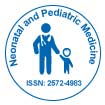Necrotizing Enterocolitis (NEC): A Life-Threatening Neonatal Condition
Received: 03-Feb-2025 / Manuscript No. nnp-25-171027 / Editor assigned: 06-Feb-2025 / PreQC No. nnp-25-171027 / Reviewed: 18-Feb-2025 / QC No. nnp-25-171027 / Revised: 22-Feb-2025 / Manuscript No. nnp-25-171027 / Published Date: 28-Feb-2025 DOI: 10.4172/2572-4983.1000512
Introduction
Necrotizing enterocolitis (NEC) is a serious gastrointestinal disease that primarily affects premature and low-birth-weight infants. It is characterized by inflammation and tissue death in the intestines, which can lead to perforation, sepsis, and in severe cases, death. NEC is one of the most common and devastating gastrointestinal emergencies in neonates. Despite advancements in neonatal care, it remains a major cause of morbidity and mortality in neonatal intensive care units (NICUs). Understanding its causes, clinical features, diagnosis, and management is essential to improving outcomes and reducing its burden [1].
Discussion
The exact cause of NEC is not fully understood, but it is believed to result from a combination of factors including intestinal immaturity, abnormal bacterial colonization, and impaired blood flow to the gut. Premature infants are at greatest risk because their intestines are underdeveloped, making them more vulnerable to injury. Additional risk factors include formula feeding (especially in preterm babies), perinatal asphyxia, and infections. Breast milk, on the other hand, has been shown to protect against NEC due to its immune and anti-inflammatory properties [2].
Clinical signs of NEC usually appear within the first few weeks of life. Early symptoms include feeding intolerance, abdominal distension, vomiting, and bloody stools. As the disease progresses, infants may develop lethargy, apnea, unstable body temperature, and signs of sepsis. In severe cases, intestinal perforation may occur, leading to peritonitis and shock. Because symptoms can overlap with other neonatal conditions, careful evaluation is required to confirm the diagnosis [3], [4].
Diagnosis of NEC involves a combination of clinical assessment, laboratory findings, and imaging studies. Abdominal X-rays are particularly important, often showing hallmark signs such as pneumatosis intestinalis (air within the intestinal wall), portal venous gas, or free air in the abdomen if perforation has occurred [5], [6]. Blood tests may reveal metabolic acidosis, low platelet count, or evidence of infection. Early recognition of these findings is critical for timely intervention.
Management of NEC depends on the severity of the disease. In mild to moderate cases, treatment includes bowel rest (stopping feedings), gastric decompression with a nasogastric tube, intravenous fluids, and broad-spectrum antibiotics to control infection. Close monitoring in the NICU is essential. For severe NEC with intestinal perforation or failure to respond to medical therapy, surgical intervention is required to remove the damaged portion of the intestine. Unfortunately, surgery carries significant risks and may lead to long-term complications such as short bowel syndrome, growth delays, or neurodevelopmental impairment [7], [8].
Prevention strategies focus on reducing risk factors. Promoting exclusive breastfeeding, minimizing unnecessary antibiotic use, and using probiotics in certain cases have been associated with reduced incidence of NEC. Advances in neonatal nutrition and careful monitoring of high-risk infants also play an important role in prevention [9], [10].
Conclusion
Necrotizing enterocolitis is a life-threatening condition that poses a major challenge in neonatal care. Premature infants are particularly at risk due to their immature intestines and susceptibility to infection. Early recognition of symptoms, prompt diagnosis, and timely management are essential to improving survival and reducing complications. While treatment options include both medical and surgical approaches, prevention—through breastfeeding, careful feeding practices, and supportive neonatal care—remains the most effective strategy. Continued research and awareness are vital to further reduce the impact of NEC and improve outcomes for vulnerable newborns.
References
- Boyle K, Felling R, Yiu A (2018) Neurologic Outcomes after Extracorporeal Membrane Oxygenation: A Systematic Review. Pediatr Crit Care Med 19: 760–766.
- von Bahr V, Kalzen H, Hultman J(2018) Long-Term Cognitive Outcome and Brain Imaging in Adults After Extracorporeal Membrane Oxygenation. Crit Care Med 46: e351–e358.
- Wien MA, Whitehead MT, Bulas D (2017) Patterns of Brain Injury in Newborns Treated with Extracorporeal Membrane Oxygenation. AJNR Am J Neuroradiol 38: 820–826.
- Carpenter JL, Yu YR, Cass DL (2018) Use of venovenous ECMO for neonatal and pediatric ECMO: a decade of experience at a tertiary children’s hospital. Pediatr Surg Int 34: 263–268.
- Hervey-Jumper SL, Annich GM, Yancon AR, Garton HJ, Muraszko KM, et al. (2011) Neurological complications of extracorporeal membrane oxygenation in children. J Neurosurg Pediatr 7: 338–344.
- Abend NS, Arndt DH, Carpenter JL (2013) Electrographic seizures in pediatric ICU patients: cohort study of risk factors and mortality. Neurology 81: 383–391.
- Payne ET, Zhao XY, Frndova H (2014) Seizure burden is independently associated with short term outcome in critically ill children. Brain 137: 1429–1438.
- Abend NS, Gutierrez-Colina AM, Topjian AA (2011) Nonconvulsive seizures are common in critically ill children. Neurology 76: 1071–1077.
- Abend NS, Dlugos DJ, Clancy RR (2013) A review of long-term EEG monitoring in critically ill children with hypoxic-ischemic encephalopathy, congenital heart disease, ECMO, and stroke. J Clin Neurophysiol 30: 134–142.
- Chen J, Zimmerman RA, Jarvik GP (2009) Perioperative stroke in infants undergoing open heart operations for congenital heart disease. Ann Thorac Surg 88: 823–829.
Citation: Zhou Q (2025) Necrotizing Enterocolitis (NEC): A Life-Threatening Neonatal Condition. Neonat Pediatr Med 11: 512. DOI: 10.4172/2572-4983.1000512
Copyright: © 2025 Zhou Q. This is an open-access article distributed under the terms of the Creative Commons Attribution License, which permits unrestricted use, distribution, and reproduction in any medium, provided the original author and source are credited.
Select your language of interest to view the total content in your interested language
Share This Article
Recommended Journals
Open Access Journals
Article Tools
Article Usage
- Total views: 227
- [From(publication date): 0-0 - Dec 09, 2025]
- Breakdown by view type
- HTML page views: 166
- PDF downloads: 61
